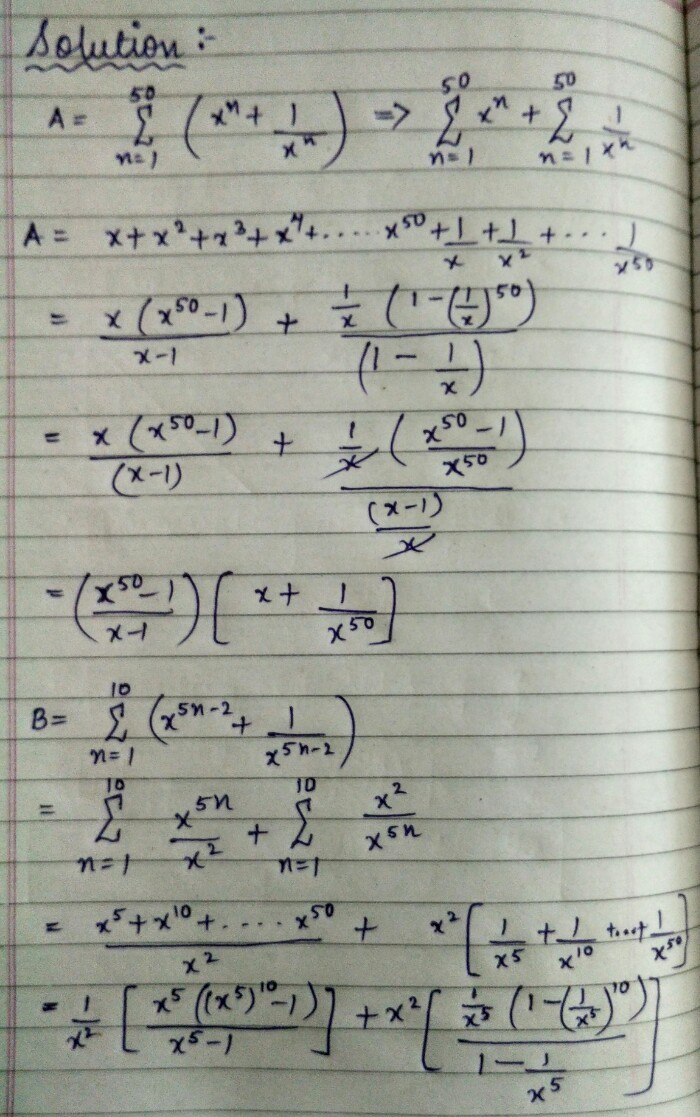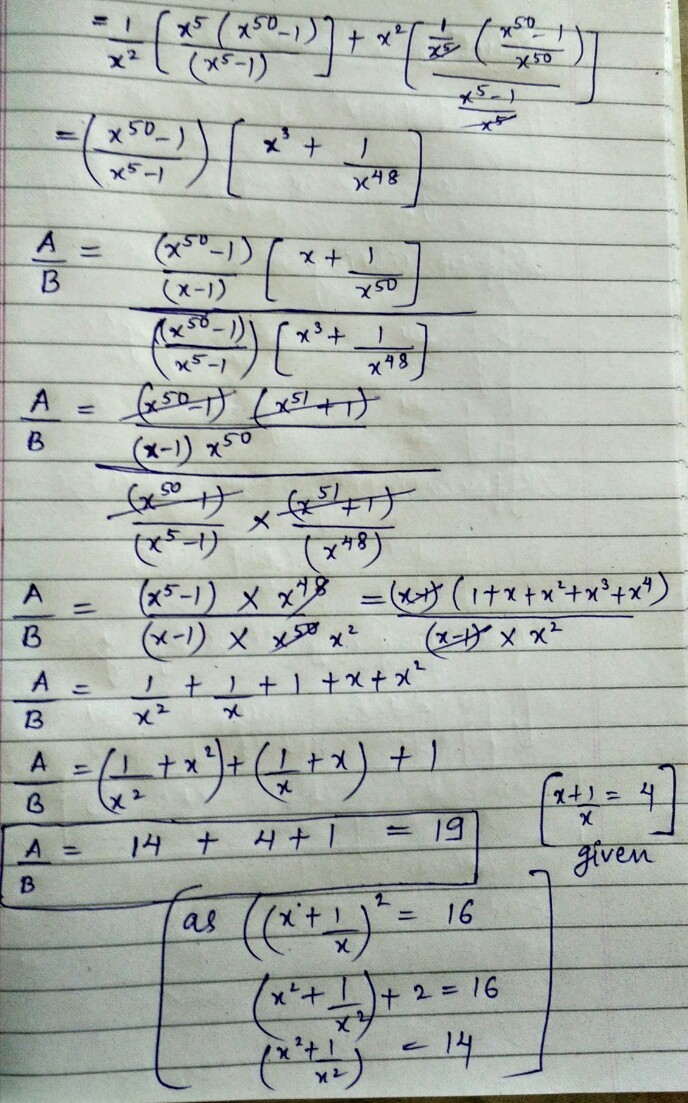The Series of Madness
A B = = n = 1 ∑ 5 0 ( x n + x n 1 ) n = 1 ∑ 1 0 ( x 5 n − 2 + x 5 n − 2 1 )
Given that x + x 1 = 4 , with A and B as described above, find the value of B A .
This is one of my original Madness problems .
The answer is 19.
This section requires Javascript.
You are seeing this because something didn't load right. We suggest you, (a) try
refreshing the page, (b) enabling javascript if it is disabled on your browser and,
finally, (c)
loading the
non-javascript version of this page
. We're sorry about the hassle.
4 solutions


Did the same thing.
Did the same method
This is a non-conventional method.
x + x 1 = 4
Let, x = e z
Then,
cosh ( z ) = 2
And,
A = n = 1 ∑ 5 0 2 cosh ( n z )
B = n = 1 ∑ 1 0 2 cosh ( ( 5 n − 2 ) z )
B A = n = 1 ∑ 1 0 2 cosh ( ( 5 n − 2 ) z ) n = 1 ∑ 5 0 2 cosh ( n z )
Using the "Angles in AP formula" for cos ( a ) in terms of cosh ( a ) [We can do that since they are in fraction]
B A = sinh ( 5 z / 2 ) sinh ( 5 0 z / 2 ) cosh ( 5 1 z / 2 ) sinh ( z / 2 ) sinh ( 5 0 z / 2 ) cosh ( 5 1 z / 2 ) = sinh ( z / 2 ) sinh ( 5 z / 2 )
B A = 2 cosh ( z ) + 2 cosh ( 2 z ) + 1
Substituting cosh ( z ) = 2 ,
B A = 1 9
Great English! +1
Similar solution, but I used cos instead of cosh .
Log in to reply
I also first used cos but then I thought it's just not good to say c o s ( x ) = 2 .
Nice way to use hyperbolic functions!!
I tried icosx
What is angles in A.P. formula ?
Let a n = x n + x n 1 .
From the hypothesis, we get x 2 + 1 = 4 x or x 2 = 4 x − 1 .
Similarly, we have x 2 1 = x 4 − 1 .
For integer n ≥ 3 , we have:
x n = x n − 2 . x 2 = x n − 2 ( 4 x − 1 ) = 4 x n − 1 − x n − 2
x n 1 = x n − 2 1 . x 2 1 = x n − 2 1 ( x 4 − 1 ) = x n − 1 4 − x n − 2 1
Thus, a n = 4 a n − 1 − a n − 2 for all integer n ≥ 3 .
For each integer n ≥ 3 , we have:
a n + 2 + a n + 1 + a n + a n − 1 + a n − 2
= 4 a n + 1 − a n + a n + 1 + a n + a n − 1 + 4 a n − 1 − a n
= 5 ( a n + 1 + a n − 1 ) − a n
= 2 0 a n − a n = 1 9 a n .
Thus,
A = n = 1 ∑ 1 0 ( a 5 n + a 5 n − 1 + a 5 n − 2 + a 5 n − 3 + a 5 n − 4 ) = n = 1 ∑ 1 0 1 9 a 5 n − 2 = 1 9 B
Or B A = 1 9 .
Good work.
That's complete brilliance .. It is such an amazing solution.!!!
You've thought lot about it.BTW I used GP
My favorite solution would be this one. Notice that, for all a , m , n ∈ Z :
( a m + a m 1 ) ( a n + a n 1 ) = a m + n + a m − n + a m − n 1 + a m + n 1
With this, then:
( a m + a m 1 ) i = − n ∑ n a i = m − n ∑ m + n ( a i + a i 1 )
By expanding B , multiplying it by i = − 2 ∑ 2 x i , and shrinking the value back to sum notation form, we get:
( x 2 + x + 1 + x 1 + x 2 1 ) B = n = 1 ∑ 1 0 ( k = − 4 ∑ 0 ( x 5 n + k + x 5 n + k 1 ) ) = n = 1 ∑ 5 0 ( x n + x n 1 ) = A
Thus, B A = x 2 + x + 1 + x 1 + x 2 1 = ( x + x 1 ) 2 + ( x + x 1 ) − 1 = 1 6 + 4 − 1 = 1 9 .
That I can say is near about what I did